Unmanned aerial vehicles (UAVs) or drones play a significant role in various industries and sectors. They are proving adaptable, reliable and effective. For example, drones provide transportation in logistics and delivery, search and rescue, infrastructure inspection, precision agriculture, disaster response, mining, urban planning, security, surveillance and space exploration.
There are many different types of drones, classified in different ways. Drones are labeled by their design, size, application or purpose. They can also be classified based on their energy source, operating environment, and regulatory class. The range of this technology is large and growing.
In this article, we will describe some common types of drones and discuss their classification.
Types of drones by design
Drones are generally classified by their design. Here are some of the most common types.
1. Single Rotor Helicopter Drones
2. Multirotor drones
3. Fixed-wing drones
4. Vertical takeoff (VTOL) fixed-wing hybrid drones
5. Drones with a tilted rotor
6. Ducted Fan Drones
7. Mixed-wing drones
Single-rotor helicopter drones feature a single, large rotor for lift and control (for altitude and direction) that functions like a conventional manned helicopter. A combination of cyclic, collective and tail rotor controls are applied to precisely maneuver the flight.
These drones are used for a variety of tasks, such as aerial photography, surveillance, remote sensing, and leisure flights. They can often carry heavier payloads and offer longer flight times compared to multi-rotor drones. They are more challenging to operate than multirotor drones, so pilots need adequate training to understand the principles of helicopter flight and master control inputs.

Multirotor drones use multiple propellers (blades) for flight and navigation, typically four to eight or more. Drones are named based on the number of rotors they have. For example:
- Tricopter – 3 rotors
- Quadcopter – 4 rotors
- Pentacopter – 5 rotors
- Hexacopter – 6 rotors
- Octocopter – 8 rotors
- Decopter – 10 rotors)
- Dodecopters – 12 rotors
The most common configurations are quadcopters, hexacopters and octocopters.
A multirotor drone produces lift by rapidly rotating its rotors. It can also hover, climb and descend by the combined lift of the rotors. The drone remains stable by controlling the lift of each rotor. It can also change its location, orientation and direction by changing the speed and direction of each rotor. The pitch or speed of the opposing rotors is adjusted to regulate the yaw.
These drones use differential thrust and speed adjustments on their rotors to gain control. They are relatively easy to operate and can hover in place without continuous pilot intervention, making them ideal for tasks such as aerial photography, videography and surveying. These drones have low payload capacity and relatively short flight times. They are available in various sizes, from small toy drones for recreational use to larger professional and industrial models for specialized tasks.
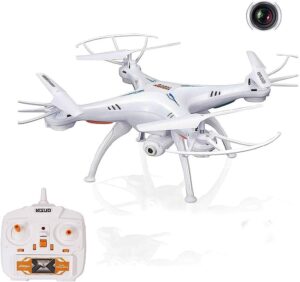
Fixed-wing drones have fixed wings and an aerodynamic design, much like airplanes. Lift is generated by the wings (rather than the rotors), which provide aerodynamics as air flows over them and the drone moves forward. In fact, fixed-wing drones are inherently stable in flight due to their aerodynamic design.
This drone has propellers, but they are mounted on the front of the drone rather than on the top, helping with forward thrust. Flight control is achieved through control surfaces such as ailerons, elevators and rudders.
Unlike multirotors, fixed-wing drones cannot hover in place and require a runway or catapult for takeoff and landing. They must maintain continuous forward motion for lift, making them efficient for long duration missions. Designed for extended flight times, these drones can fly for several hours on a single battery charge or longer with fuel-powered engines. They can also carry heavy payloads and are capable of autonomous flight, allowing them to follow pre-programmed flight paths or respond to specific mission objectives without constant pilot intervention.
As a result, fixed-wing drones are commonly used for applications such as aerial mapping, agriculture (e.g., crop monitoring), environmental monitoring, long-range surveillance, wildlife tracking, and geospatial data collection.
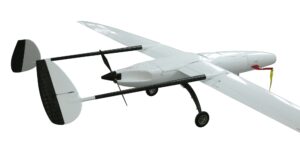
Hybrid VTOL drones combine the features of fixed-wing and multi-rotor drones. They are capable of taking off and landing vertically like multirotor drones, so they can operate in confined spaces without a runway or catapult launch. These drones also have fixed-wing capabilities, meaning they can transition from vertical takeoff to horizontal flight, similar to airplanes.
Once in flight mode, they cover greater distances more efficiently than multirotor drones. These hybrids use advanced flight control systems to transition between vertical takeoff and fixed-wing flight. The transition process typically involves changing the orientation of the drone's rotors and adjusting the thrust vectors. After completing their missions, hybrid VTOLs can return to a vertical landing, allowing them to land in tight spaces or on small landing pads. Many hybrid VTOL drones also have autonomous flight capabilities.
These drones can carry a large payload and cover long distances, making them useful for aerial mapping, surveillance, cargo delivery and environmental monitoring.
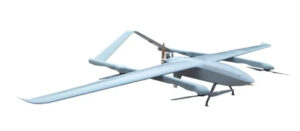
Tilted rotor drones combine the characteristics of a helicopter and a fixed-wing aircraft. They have rotor systems that can tilt from a vertical to a horizontal position, allowing them to take off and land vertically like a helicopter and then transition to fixed-wing flight for efficient cruising.
In a vertical position, the rotors provide vertical lift for takeoff and landing. In the horizontal position, the rotors act as propellers for forward flight. These drones use advanced flight control systems, which efficiently manage vertical and horizontal transitions. This involves changing the orientation of the rotors and adjusting the thrust vectors. Many have autonomous flight capabilities.
Tilted-rotor drones typically carry large payloads, cover long distances, and are used for long-range reconnaissance, surveillance, and transportation of goods in remote or challenging environments.
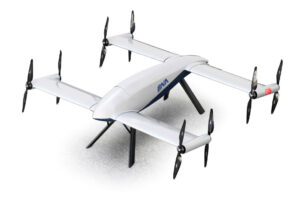
Ducted fan drones have a propulsion system comprising one or more fans encased in a duct or protective shroud. This means they can take advantage of ducted fans for a variety of applications. The duct protects the fan blades and provides additional lift and control. It also ensures that the blades are protected and will not be damaged or injured in the event of a collision.
These drones benefit from greater lift and stability compared to open rotor designs. The ducted fan also produces less noise than open rotor configurations. By varying the speed and direction of rotation of the fans, the drone controls its movement in different directions. The duct provides additional aerodynamic lift, making them more efficient for hovering and low-speed flying.
These drones are more compact and smaller compared to other types. Due to a smaller footprint, there are limitations in payload capacity compared to larger UAVs. Ducted fan drones are used for specialized tasks such as inspecting pipelines, tunnels and internal structures where maneuverability and stability are critical.
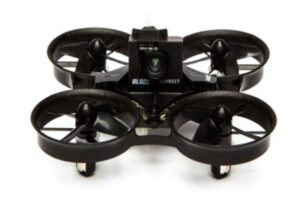
Blended wing body (BWB) drones have a mixed design of wing and fuselage to improve aerodynamics, which is unique. The design results in a wing-shaped lifting body, with minimal distinction between the main body and the wings. This drone relies on your body to generate lift. The blended shape creates lift through aerodynamic forces and its overall shape. There could be one or more propellers or jet engines to provide thrust for forward motion. Some BWB drones are designed with VTOL capabilities, allowing them to take off and land vertically.
BWB drones can carry large payloads and cover longer distances with decent fuel efficiency. They are used for aerial mapping, surveillance, cargo delivery, scientific research and military reconnaissance. Their efficiency and load capacity make them versatile machines for many sectors.
Types of drones by size
The weight and size range for drone classification may vary depending on local regulations and standards. In the United States, the Federal Aviation Administration (FAA) classifies drones based on their weight to establish rules and regulations for their safe operation. These regulations may include restrictions on where and how drones can fly, registration requirements, and pilot certification.
As advances in drone technology occur, classification criteria change. Currently, the classification of drones based on size is listed below.
1. Nano
2. Micro
3. Mini
4. Small
5. Medium
6. Big
Nanodrones are typically less than 250 grams and small enough to fit in the palm of your hand. They are used for indoor and outdoor recreational flying, educational purposes, and basic aerial photography.
Microdrones weigh between 250 grams and two kilograms. They are a little larger than nano drones, but still compact. Micro drones are used for recreational flying, aerial photography and educational purposes.
Mini drones weigh between two and 25 kilos. They are larger than micro drones, but still relatively small. Mini drones are used for aerial photography, videography, recreational flying, and professional applications like agriculture and surveying.
Small drones weigh between 25 and 150 pounds. They are larger and more substantial than mini drones. Small drones are used in applications such as surveillance, inspection, aerial mapping and cargo transportation.
Average drones weigh between 150 and 600 kilograms. They are used in advanced professional applications such as agricultural spraying, environmental monitoring, and some military or defense applications.
Large drones weigh between 600 kilograms and several tons. They are so big that they resemble small aircraft. Large drones are used for heavy-lift transport, military reconnaissance, long-range surveillance, and large-scale mapping and surveying.
Types of drones by technology
Typically, drones are a type of unmanned aerial vehicle. However, as technology advances, drones include new devices. Various unmanned or remotely controlled vehicles are now also called drones.
These drones are categorized based on the type of vehicle they are:
1. Unmanned Aerial Vehicles (UAV)
2. Unmanned Underwater Vehicles (UUV)
3. Micro Aerial Vehicles (MAV)
4. Nano Aerial Vehicles (NAV)
5. Personal Air Vehicles (PAV)
6. Submersible Drones (SD)
Unmanned Aerial Vehicles (UAVs) are aircraft that operate without a human pilot on board. These vehicles can be designed to fly autonomously, following predetermined flight patterns or reacting to real-time data – or a human operator can control them remotely.
Unmanned underwater vehicles (UUVs) are autonomous or remotely operated vehicles designed to operate below the water's surface without a human pilot. They are used in diverse applications, including oceanography, marine biology, underwater archaeology, hydrographic surveying, underwater resource exploration, and military tasks such as mine countermeasures, anti-submarine warfare, as well as intelligence, surveillance and reconnaissance (ISR).
Micro Aerial Vehicles (MAV) are small, lightweight unmanned aerial vehicles. These small aircraft are often designed to mimic the flight characteristics of insects or birds and are typically used for applications that require small, agile drones. They are used for indoor mapping, monitoring confined spaces, or swarming for surveillance.
Nano Aerial Vehicles (NAV) are extremely small, light and agile drones for specific applications that require micro-sized aircraft. Its design is also inspired by the flight characteristics of insects and is used for tasks such as surveillance, recognition and environmental monitoring in tight or confined spaces.
Personal Aerial Vehicles (PAV) transport one or more passengers, typically in a small, compact and often electrically powered vehicle. They are being developed to provide regional and urban transport options, potentially reducing traffic congestion and offering future forms of efficient and practical personal transport. A good example of PAVs are air taxis.
Submersible Drones (SD) , also known as underwater drones or remotely operated underwater vehicles (ROVs), are autonomous or remotely controlled vehicles designed to operate underwater. They are used to explore underwater environments that are difficult or dangerous for humans to access. They can reach great depths in the ocean and explore underwater caves, shipwrecks, and other submerged features. These drones are used for underwater exploration, oceanography, underwater archeology and recreational purposes.
Types of drones by application
Drones are versatile machines used in many applications and equipped accordingly. Here are some types of drones based on purpose.
Drones for photography and videography capture high-quality images and videos from the air. They are equipped with stabilized gimbals and high-resolution cameras. They are used in film production, aerial photography and content creation.
Agricultural drones are used in agriculture for crop monitoring, pest control and precision agriculture. They have sensors to collect data on crop health and soil conditions.
Search and rescue drones assist in search and rescue operations by providing real-time aerial images. They have thermal cameras and sensors to locate missing people in challenging terrain.
Racing drones are used for recreational purposes and drone racing competitions. They offer speed, agility and the performance of acrobatic maneuvers.
Entertainment and drone shows are used in large-scale entertainment events and aerial light shows. They are programmed to create coordinated visual displays in the night sky and often have laser or LED lights.
Delivery drones carry goods from one location to another, typically for e-commerce or logistics companies.
Drone mapping and surveying are used to create detailed maps, 3D models, and topographical land surveys. They are commonly used in construction, mining and land development.
Military and defense drones (UCAVs – Unmanned Combat Aerial Vehicles) are used by the armed forces for reconnaissance, surveillance and sometimes combat missions. These can range from small surveillance drones to larger armed platforms.
Scientific research drones are used for various scientific purposes, including climate research, atmospheric sampling, and geological surveys.
Educational and training drones are designed for educational purposes and training new drone operators. They provide a safe and controlled environment to learn about UAV technology.
Infrastructure inspection drones inspect critical infrastructure such as bridges, power lines and pipelines. With the help of these drones, there is often no need for human inspectors to work in dangerous conditions.
Oil and gas industry drones are used in oil and gas operations for pipeline monitoring, flare stack inspection, and offshore platform maintenance.
Environmental monitoring drones are used for ecological research and conservation. They help with tracking wildlife, monitoring habitats and assessing ecological changes.
Medical and healthcare drones are in development and could be used for transporting medical supplies, organ delivery, and emergency medical response.
Space exploration drones (planetary rovers) are used for planetary exploration on celestial bodies such as Mars and the Moon. They collect data and images to advance our understanding of space and planets.
Types of drones by environment
Drones can also be categorized based on the environment they operate in as follows.
Indoor drones are designed to fly indoors, such as warehouses, factories, and indoor arenas. These micro or mini drones can navigate tight spaces and are used for indoor mapping, inventory management and inspections.
Outdoor drones operate in open outdoor spaces, from rural areas to urban environments. They are used for aerial photography, surveillance, agriculture and recreational flying.
Urban drones are used in urban environments, which require obstacle avoidance systems and the ability to navigate complex airspaces. They are used for urban surveillance, infrastructure inspection and aerial photography in cities.
Rural and agricultural drones typically fly in open fields, farms, and rural areas. They are used for precision agriculture, crop monitoring and pesticide application.
Mountain and high-altitude drones are equipped for operation in mountainous or high-altitude environments, often featuring enhanced altitude capabilities and rugged designs. They are commonly used for mountain search and rescue or alpine surveys.
Maritime drones operate over or under water, including oceans, seas, rivers and lakes. They are used in ocean exploration, marine research, underwater inspections and search and rescue missions.
Coastal and marine drones are built to resist the corrosive effects of salt water and operate in coastal and marine environments. They are used for coastal monitoring, marine research and ocean conservation efforts.
Desert drones can withstand high temperatures, blowing sand and low humidity in desert environments. They are used for mapping, monitoring and environmental research of desert terrain.
Forestry and wildfire drones monitor and manage forest areas, detect wildfires and map forest health. They help with wildfire prevention and response efforts.
Jungle and rainforest drones navigate dense vegetation and high humidity in rainforests and jungles. They are used for biodiversity research, environmental monitoring and wildlife conservation.
Alpine drones are designed for snowy and alpine environments and are often used for avalanche monitoring, snowpack analysis, and winter search and rescue.
Arctic and Antarctic drones can withstand extreme cold, harsh conditions and icy environments in polar regions. They are used for scientific research, environmental monitoring and wildlife observation in the Arctic and Antarctic regions.
Underground drones are used in mining and tunneling operations to navigate and inspect underground passages. They guarantee safety and efficiency in underground environments.
Space exploration drones are used in planetary exploration on celestial bodies such as Mars and the Moon.
Extreme weather drones are designed to withstand severe weather conditions such as hurricanes, tornadoes, and other extreme weather events. They are used for meteorological research and monitoring.
Types of drones by autonomy and control
These drones are categorized by the level of autonomy and control they have.
Manual drones are controlled entirely by a human operator.
Semi-autonomous drones perform some tasks autonomously, but with human supervision.
Autonomous drones are designed to operate without direct human intervention. They rely on sensors and artificial intelligence for autonomous flights and mission completion.
Types of drones by power source
Based on the power sources, there are the following types of drones.
Battery-powered drones include electric drones powered by rechargeable lithium polymer (LiPo) or lithium-ion (Li-ion) batteries. They are commonly used for home and professional use. However, due to the use of batteries, they have limited flight time and require periodic recharging. These drones are lightweight and suitable for a wide range of applications. They operate silently and have zero emissions.
Gasoline-powered drones operate on internal combustion engines that run on gasoline or other liquid fuels. Compared to battery-powered drones, these drones have longer flight times and can carry heavy payloads. These are typically large drones designed for extended missions.
Hybrid drones combine electrical and gasoline power sources to balance extended flight duration and reduced emissions. They are more versatile and heavier than electric or gasoline drones.
Solar-powered drones have panels on the wings or surfaces to capture solar energy and recharge the onboard batteries. They depend on sunlight to recharge, so they have limited flight in cloudy and nighttime conditions. However, they are environmentally friendly and have greater resistance to flying when exposed to sunlight.
Fuel cell-powered drones use hydrogen fuel cells to generate electricity for propulsion and onboard systems. These drones feature resistance to long flights, excellent energy efficiency and reduced emissions. However, they are expensive and hydrogen refueling infrastructure is limited.
Tethered drones receive power and data through the cable. They remain connected to a terrestrial power source via a tether, which gives them unlimited flight time (as long as they are tethered), continuous power, and stable communication. However, its mobility, altitude and range are limited.
Nuclear-powered drones are in development and could utilize small nuclear reactors as a power source for extended missions, particularly in space exploration. They are complex and expensive to design and engineer. These drones are just a theoretical concept with the potential for extremely long missions, particularly in deep space.
Types of drones by regulatory class
There are different regulatory bodies for drones in most countries. The regulatory body for drones is as follows for these countries:
- The Federal Aviation Administration (FAA) is the U.S.
- The European Union Aviation Safety Agency (EASA) in the European Union
- The Civil Aviation Authority (CAA) in the United Kingdom
- The Directorate General of Civil Aviation (DGCA) in India.
The most common regulatory classes for drones are as follows:
The open class includes drones that weigh less than 250 grams and have a maximum speed of 19 m/s. These drones are subject to minimal restrictions and can fly without a license or registration.
Specific class includes drones that do not meet the open class requirements. These drones may require a license, registration, or other authorization to fly.
The certified class includes drones designed for commercial or industrial use. These drones must meet rigorous safety standards and are subject to the strictest regulations.

